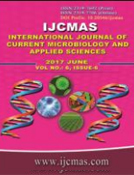


 National Academy of Agricultural Sciences (NAAS)
National Academy of Agricultural Sciences (NAAS)

|
PRINT ISSN : 2319-7692
Online ISSN : 2319-7706 Issues : 12 per year Publisher : Excellent Publishers Email : editorijcmas@gmail.com / submit@ijcmas.com Editor-in-chief: Dr.M.Prakash Index Copernicus ICV 2018: 95.39 NAAS RATING 2020: 5.38 |
Poor quality water is adversely affecting the performance of pearl millet crop. Cultivation of salinity tolerant pearl millet may be adapted as strategies for ensuring yield and good quality through effective use of poor quality water. Therefore, we attempted to evaluate the performance of pearlmillet under salinity levels of irrigation water [normal (~0.6 dSm-1) and saline 3, 6 and 9 dS m-1 water] and two genotypes [AVKB-19 and ICMV-15111]. The maximum plant population per meter row length (11.96, 10.89 and 10.64), maximum No. of leaves/plant (75.06, 44.46 and 68.62), maximum No. of Tillers/plant (7.83, 3.23 and 5.09), highest Plant height (cm) (194.28, 88.49 and120.5), and highest Stem girth (mm) (26.38, 20.79 and 23.79) at 50DAS, 30 DA 1st cut and 60 DA 1st cut, respectively recorded under the experimental plots irrigated with good quality water. Among the genotypes, the maximum plant population per meter row length (10.61, 9.65 and 8.90), maximum No. of leaves/plant (64.5, 37.19 and 59.99), highest Plant height (cm) (182.19, 80.6 and 121.1), and highest Stem girth (mm) (23.08, 17.72 and 19.48) at 50DAS, 30 DA 1st cut and 60 DA 1st cut, respectively recorded under the experimental plots with AVKB-19. Maximum No. of Tillers/plant recorded (7.69) with AVKB-19 at 50DAS, but in contrast maximum (2.98 and 4.40 at 30 DA 1st cut and 60 DA 1st cut) under ICMV15111. The maximum No. of effective tiller/plant (4.25), highest Ear head length (cm) (27.93), highest Ear head girth (cm) (8.38), maximum 1000-grain weight (gram) (7.35), and maximum No. of grain per Ear head (1869.94) recorded under the experimental plots irrigated with good quality water. Among the varieties, the maximum No. of effective tiller/plant (4.02), highest Ear head length (cm) (26.88), highest Ear head girth (cm) (7.87), maximum 1000-grain weight (gram) (7.25), and maximum No. of grain per Ear head (1612.26) was recorded with AVKB-19. Genotype AVKB-19 produced significantly higher (16.26%) mean grain yield of 1.93 t/ha as compared to 1.66 t/ha in ICMV-15111. Increase in the salt concentrations of irrigation water from good quality to EC 9.0 dS/m caused significant decrease in grain yield. The significant reduction (37.44%) was observed mainly at the higher salinity (9 dS/m) of irrigation water compared to the good quality water, whereas, it was 9.90 and 20.80% at EC 3.0 and 6.0 dS/m, respectively. The maximum value for crude protein content (CP) (10.15%), Ether extract (EE) (4.39%), organic matter content (OM) (97.15%), and Cell soluble content (67.32%) recorded in AVKB-19. In contrast, ICMV-15111recorded maximum value for Dry matter content (DM) (90.78%), Ash (3.10%), Neutral Detergent Fibre (NDF) (34.09), Acid Detergent Fibre (ADF) (6.08%), Hemicellulose content (HC) (28.51%) and Total Carbohydrate content (T-CHO) (83.04%).In general crude protein content, In computation of economics for treatments highest benefit cost ratio was obtained with good quality of irrigation water (1.2), whereas lowest was obtained with 9 EC of irrigation water (0.5) while comparing the variety for highest benefit cost ratio the AVKB 19 (1.1) found higher in comparison to ICMV 15111(0.9).
 |
 |
 |
 |
 |